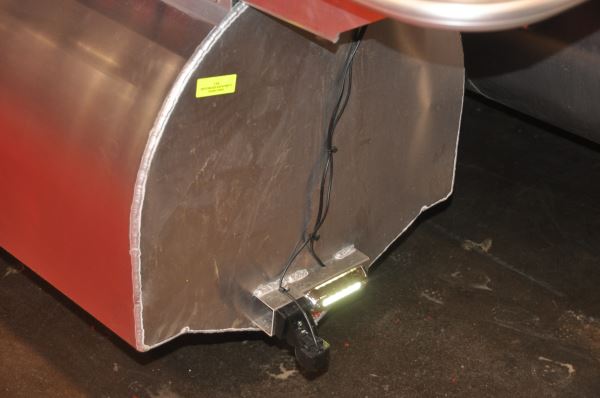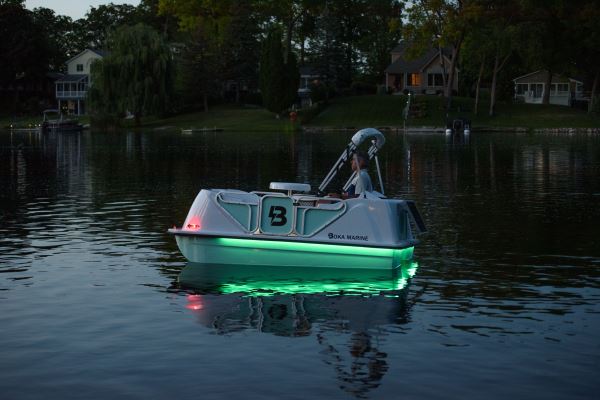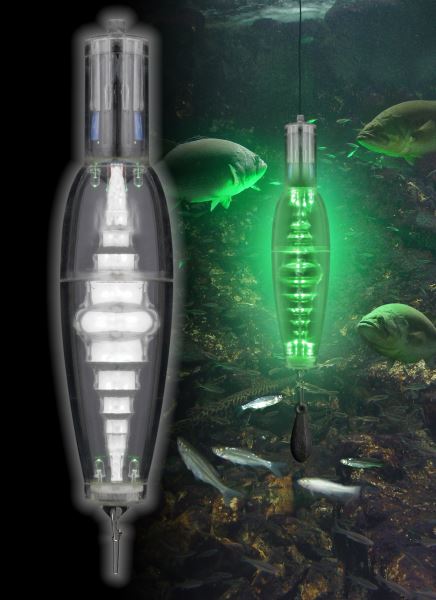Our warmest month is also the most popular with anglers who fish at night. The most obvious reason for that correlation is that fishermen who wet lines post-sunset are doing so to avoid the blistering heat and damaging rays of the sun that plagues their daytime efforts and those of anglers who just can’t wrap their heads around fishing after dark.
I get it. I would much rather watch a bass crash a surface bait, a dayglo bobber suddenly plunge beneath the surface or a rod start dancing in the rod holder before assuming a deep, throbbing bend at the pull of a fish. Two out of three of those scenarios are available to after-dark anglers, with the exception of a crashing surface hit beyond the circle of light, but some would argue that the sound alone is enough to trigger a memorable hookset.
OEM and aftermarket underwater lights for fishing are available with mounts specifically for pontoon logs.
 The problem is, this time of year those scenarios may not be options for traditional daylight fishing times and tactics due to the conditions, a combination of heat, light and for some species, lethargy that puts them off their feed and makes them sedentary. That can make the fish harder to locate, but even when found, some species just don’t want to bite during daylight come summer.
The problem is, this time of year those scenarios may not be options for traditional daylight fishing times and tactics due to the conditions, a combination of heat, light and for some species, lethargy that puts them off their feed and makes them sedentary. That can make the fish harder to locate, but even when found, some species just don’t want to bite during daylight come summer.
That can change when the sun slips below the horizon. Light-sensitive gamefish such as walleyes move into the shallows to chase bait, bass leave the weeds for more open areas to pursue their prey, and panfish that have schooled over deep water to escape the heat during the day will move shallower. And, of course, famous night biters catfish go on the prowl, cruising shallow points, flats and beaches in search of other critters that come out after dark, including crawfish and insect larvae that emerge from the mud. Naturally, that emerging “food” attracts more than resident catfish, but you get my drift.
Yes, fishing at night has its own obstacles. I detailed those issues in this column nearly a decade ago, but if from the get-go you approach a fishing trip that might extend past sunset, you can overcome a lack of the sun’s ever-present overhead lighting and take advantage of what may be the fastest fishing you’ll experience all summer.
Night anglers accomplish that by concentrating the fish near their boat and then matching the hatch with the baits they know the gamefish will want to eat. Note that I said concentrating the fish – not just the gamefish – nearby. The key is getting baitfish to gather, and the gamefish will follow to feed.
 In my angling experience, there are three primary ways of attracting fish to a particular area: using chum, sound, or light. Chum is any substance introduced into the water, such as chopped bait, pet food, fish oil, grain or a combination, to attract fish. Chum relies on current to take the scent and bits of the attractant far and wide, to where fish may be hanging out in hopes of and triggering them into feeding and following the scent up-current within casting distance of the boat. While there is current in rivers, freshwater reservoirs and even on smaller lakes, chumming remains primarily a saltwater tactic due to ever-changing tides producing near-continual current.
In my angling experience, there are three primary ways of attracting fish to a particular area: using chum, sound, or light. Chum is any substance introduced into the water, such as chopped bait, pet food, fish oil, grain or a combination, to attract fish. Chum relies on current to take the scent and bits of the attractant far and wide, to where fish may be hanging out in hopes of and triggering them into feeding and following the scent up-current within casting distance of the boat. While there is current in rivers, freshwater reservoirs and even on smaller lakes, chumming remains primarily a saltwater tactic due to ever-changing tides producing near-continual current.
Waterproof LED lights designed for use underwater for aesthetics and angling are standard on many boats these days, and are popular among night-time fishermen who find that shades of green are most productive at attracting baitfish and the gamefish that follow.
Sound as a fish-attractant is a bit trickier. While most anglers avoid making excess noise, fearing the vibrations will alert fish to their presence, in some fishing situations it’s common to make noise to get the fish interested in what’s taking place to create it. Commercial hook-and-line tuna fishermen blast the ocean’s surface with a constant spray of water to simulate baitfish splashing. Bream anglers in the south may use poles to beat open areas in dense surface weed beds, not only to create a hole in which to drop a bait, but to knock insects and other fish food into the water to attract the local panfish, almost like live chum. They’ll even smack the water with the pole a few times if the bite slows, hoping to return the area fish to feeding mode. Charter captains on the Great Lakes in pursuit of yellow perch often leave their inboard engines running while at anchor over schools of fish. They swear the rumbling not only attracts perch to below the boat but can wake residents from their lethargy and get them to bite emerald shiners dropped in their midst.
Both chum and sound can be used at night to bring fish within catching distance of your boat, in fresh and saltwater, but nothing works to attract fish at night – both game and bait – like artificial light.
Fishermen have been using light to help catch fish after dark for eons. Our forefathers used to carry torches or light pyres off the bow of their boats to illuminate the water below to attract baitfish and gamefish, a primitive angling method that is still used by subsistence fishermen today.
Beyond fish attraction, if you are night fishing you’ll need lights on deck to see and be seen. I hang an LED lantern from the middle bow of my Bimini top, which I deploy for that purpose and to reflect the light a bit to help illuminate the deck below. I also wear a headlamp when actually fishing, although it’s only turned on when I need a focused beam of powerful light to bait a hook or release a fish.
Courtesy lights in the form of LED strips make good, subdued working illumination aboard a boat. They are inexpensive, easy to wire and mount, some coming with self-adhesive tape to stick to the underside of rails or furniture, and they draw minimal juice from the battery. I have experimented with ultraviolet “black” lights made for night fishing, but preferred overhead and strip lights aboard, and underwater LEDs for below-fish-attracting illumination.
 For the latter, gas or kerosene lanterns are still used by night fishermen today, and anglers suspend lanterns and electric lights just over the water from docks or boats to allow their glow to attract flying bugs and baitfish – and the gamefish that follow. By placing the lights directly atop – or under – the water, you can minimize the annoying flying insect they draw, bugs which some fishermen argue actually helps the fishing, while directing the illumination into the depths. Whether cast from above or below the waterline, the artificial light attracts microscopic phytoplankton, followed by zooplankton and the baitfish that feed on both. If there are larger predator fish in the area, they will follow the baitfish and end up within casting range of the lighted area around your boat.
For the latter, gas or kerosene lanterns are still used by night fishermen today, and anglers suspend lanterns and electric lights just over the water from docks or boats to allow their glow to attract flying bugs and baitfish – and the gamefish that follow. By placing the lights directly atop – or under – the water, you can minimize the annoying flying insect they draw, bugs which some fishermen argue actually helps the fishing, while directing the illumination into the depths. Whether cast from above or below the waterline, the artificial light attracts microscopic phytoplankton, followed by zooplankton and the baitfish that feed on both. If there are larger predator fish in the area, they will follow the baitfish and end up within casting range of the lighted area around your boat.
Portable underwater fishing lights that plug into a 12-volt receptacle are a popular option among anglers who don’t intend to fish after dark very often but want the option of fish-attracting light to the pontoon or deck boat when they do.
Walleyes are popular targets for after-dark anglers seeking to beat the heat and hook up with a species that actually prefers to feed at night.
Boat anglers have their choice of everything from automobile headlamps floating in Styrofoam to a wide selection of portable, waterproof 12-volt lights that can be lowered over the side to attract fish. All are effective, but none have attracted the following – or the fish – like the aftermarket LED underwater lights that are designed for more or less permanent application aboard boats.
 Several pontoon and deck boat manufacturers now offer underwater LED lights as optional equipment. On pontoon boats, the lights are usually fitted to the brackets designed to hold washdown and livewell pumps and fish finder transducers and don’t interfere with those applications. Deck boats use underwater LED’s, OEM or aftermarket models, attached to the transom just below the waterline. Several aftermarket underwater LED lights manufacturers offer models or kits to allow their lights to be mounted on trim tabs, which is an option for deck boats, as well.
Several pontoon and deck boat manufacturers now offer underwater LED lights as optional equipment. On pontoon boats, the lights are usually fitted to the brackets designed to hold washdown and livewell pumps and fish finder transducers and don’t interfere with those applications. Deck boats use underwater LED’s, OEM or aftermarket models, attached to the transom just below the waterline. Several aftermarket underwater LED lights manufacturers offer models or kits to allow their lights to be mounted on trim tabs, which is an option for deck boats, as well.
Underwater fishing lights are available in three primary colors: white, blue and green. Studies show that white and green wavelengths of light are most attractive to plankton, which is a primary food of many baitfish. Plankton migrate to light for reproduction, and tests show that both green and white lights are effective. However, white light is absorbed very quickly in water and doesn’t penetrate very deep, so it’s less effective than green, which maintains its color character at much greater distances and depths. Blue light, as with green, has a greater distance of effectiveness than white, according to the research, and some fish – baitfish and gamefish – are attracted directly by the lights rather than the plankton or bait.
You’ll know soon enough if you are casting your light over a productive area when microscopic “squiggles” of phytoplankton and zooplankton show up right at the light; minnows should soon follow. When you start to hear splashes or see shadows of larger fish darting through or suspending just beyond the edge of light, you’ll know that the predators have shown up, and it’s time to get busy fooling the gamefish with live baits and lures.
Dan’s Pick
.jpg_600.jpg) Sea-Doo Switch Sport 21
Sea-Doo Switch Sport 21
There’s one of these Supercharged Switch pontoons at my local lake and it turns heads wherever it cruises. And with a 230hp (170hp standard) Rotax 1.6L ACE engine, the new Sea-Doo gets there QUICK! During the ride, occupants get to take advantage of a cool, flush-mount sport lounge seating area offering sun pads and backrests on the bow, and wrap around lounge seating on the aft end of the playpen, protected overhead by a quality, standard Bimini top.
Granted, beyond a Garmin touchscreen GPS, there are not a lot of fishing options (can you say underwater lights!) available with the Switch. However, that simply opens up the boat for your customization with aftermarket angling accessories of your choice and we’ve been told new fishing-specific accessories from BRP are coming soon.
Just know that no matter how you rig it, aboard the Switch you and your crew may be the center of attention on your local waters, and be prepared to yell, “It’s a Sea-Doo!” in answer to fellow boaters’ inquiries and lingering gazes as you cruise past aboard this distinctive pontoon boat.
ABOVE AND BELOW WATER LIGHT SOURCES
Aqualuma Underwater
Lighting
www.aqualuma.com
Attwood Marine
www.attwoodmarine.com
Berkley
www.berkley-fishing.com
Briter Innovations
www.briterinnovations.com
Bass Pro Shops
www.basspro.com
Cabela’s
www.cabelas.com
Hella Marine
www.hellamarine.com
Hydraglow
www.hydroglow.com
H2O
www.h2olights.com
Lumitec
www.lumiteclighting.com
OceanLED
www.oceanled.com
Optronics
www.optronicsinc.com
West Marine
www.westmarine.com

